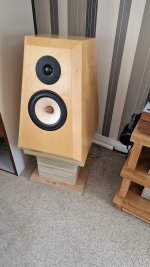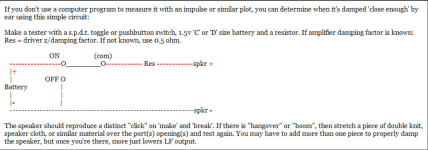What do you think is the most effective filling material for a ported enclosure.
What about angel hair, assume still keeping port and rear of woofer free?
Also would you line the cabinet walls? If so with what?
My cabinets are manufactured in birch ply nearly 50mm thick!
Thanks.
What about angel hair, assume still keeping port and rear of woofer free?
Also would you line the cabinet walls? If so with what?
My cabinets are manufactured in birch ply nearly 50mm thick!
Thanks.
Attachments
They say you should be careful not to waste bass by over damping.
Dealing with box modes is no less important with a vented box. It’s easy to put too much emphasis on the first, and forget that the second can be the greater problem.
Dealing with box modes is no less important with a vented box. It’s easy to put too much emphasis on the first, and forget that the second can be the greater problem.
It completely depends on your goals. In a subwoofer, assuming the wavelength associated with the highest frequency to be reproduced is far bigger than any internal dimension, adding damping makes little sense. In a traditional two-way however, you have to adjust the type, amount and placement of the damping carefully to achieve your goals wrt resonances vs. low frequency reproduction. The only practical way without BEM/FEM is trial and error, and assumes you have access to a decent microphone and audio measurement gear.
For subwoofers, don't forget harmonic distortion will be relatively high, and the harmonics might excite cavity resonances. In practice, the 5th harmonic might prove the most troublesome (?).
Yeah, Altec's top, one side, back covered with 1" acoustic fiberglass insulation and later with OC703 duct board works well without over damping, then critically damping the vent yields the SQ.
Attachments
I suggest that reading the article by James Moir, "Ported Loudspeaker Cabinets" that was published in 'Audio' October 1956 would be helpful. Covering the internal walls with a fibrous layer has little effect on reducing standing waves within the enclosure. Moir advocated fitting a curtain with a 180 degree twist from the top panel to the bottom one . Tontine , a polyester wadding approx. 25 mm thick is suitable for this function.
I remember studies by (I think) B&W that showed that loose damping materials in an enclosure tend to vibrate and thus behave nonlinear and less effective. I use bracings to mount any damping mats that are not on enclosure walls.
Like many builders do i sing into the woofer mounting hole, i even do frequency sweeps with my voice, it is very easy to hear if the size of the damping is correct or not, for slim floorstander i usally end up with a thick piece of glass wool in the bottom and then a thinner piece just behind the drivers, finally i check the result by tapping with my fingers in fast drum rolls on the woofer cone when mounted in the cab, also very easy to hear if the damping is successful or not
Mine are rear ported.I suggest that reading the article by James Moir, "Ported Loudspeaker Cabinets" that was published in 'Audio' October 1956 would be helpful. Covering the internal walls with a fibrous layer has little effect on reducing standing waves within the enclosure. Moir advocated fitting a curtain with a 180 degree twist from the top panel to the bottom one . Tontine , a polyester wadding approx. 25 mm thick is suitable for this function.
So was thinking of trying a piece of polyester at an angle 45 degrees, from front to rear?
- Home
- Loudspeakers
- Multi-Way
- Ported box cabinet wadding lining

